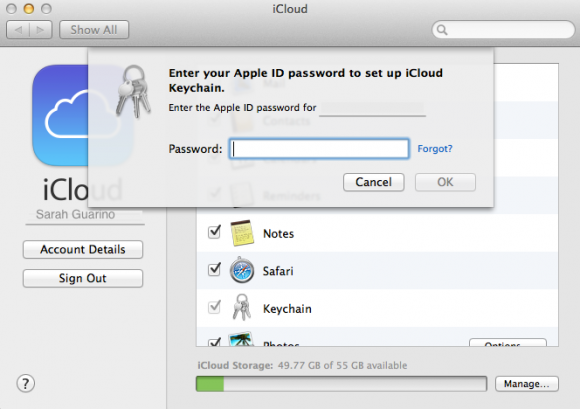Critical Flaws in Apple, Samsung Devices
mercredi 17 juin 2015 à 19:15Normally, I don’t cover vulnerabilities about which the user can do little or nothing to prevent, but two newly detailed flaws affecting hundreds of millions of Android, iOS and Apple products probably deserve special exceptions.
 The first is a zero-day bug in iOS and OS X that allows the theft of both Keychain (Apple’s password management system) and app passwords. The flaw, first revealed in an academic paper (PDF) released by researchers from Indiana University, Peking University and the Georgia Institute of Technology, involves a vulnerability in Apple’s latest operating system versions that enable an app approved for download by the Apple Store to gain unauthorized access to other apps’ sensitive data.
The first is a zero-day bug in iOS and OS X that allows the theft of both Keychain (Apple’s password management system) and app passwords. The flaw, first revealed in an academic paper (PDF) released by researchers from Indiana University, Peking University and the Georgia Institute of Technology, involves a vulnerability in Apple’s latest operating system versions that enable an app approved for download by the Apple Store to gain unauthorized access to other apps’ sensitive data.
“More specifically, we found that the inter-app interaction services, including the keychain…can be exploited…to steal such confidential information as the passwords for iCloud, email and bank, and the secret token of Evernote,” the researchers wrote.
The team said they tested their findings by circumventing the restrictive security checks of the Apple Store, and that their attack apps were approved by the App Store in January 2015. According to the researchers, more than 88 percent of apps were “completely exposed” to the attack.
News of the research was first reported by The Register, which said that Apple was initially notified in October 2014 and that in February 2015 the company asked researchers to hold off disclosure for six months.
“The team was able to raid banking credentials from Google Chrome on the latest Mac OS X 10.10.3, using a sandboxed app to steal the system’s keychain and secret iCloud tokens, and passwords from password vaults,” The Register wrote. “Google’s Chromium security team was more responsive and removed Keychain integration for Chrome noting that it could likely not be solved at the application level. AgileBits, owner of popular software 1Password, said it could not find a way to ward off the attacks or make the malware ‘work harder’ some four months after disclosure.”
A story at 9to5mac.com suggests the malware the researchers created to run their experiments can’t directly access existing keychain entries, but instead does so indirectly by forcing users to log in manually and then capturing those credentials in a newly-created entry.
“For now, the best advice would appear to be cautious in downloading apps from unknown developers – even from the iOS and Mac App Stores – and to be alert to any occasion where you are asked to login manually when that login is usually done by Keychain,” 9to5’s Ben Lovejoy writes.
SAMSUNG KEYBOARD FLAW
Separately, researchers at mobile security firm NowSecure disclosed they’d found a serious vulnerability in a third-party keyboard app that is pre-installed on more than 600 million Samsung mobile devices — including the recently released Galaxy S6 — that allows attackers to remotely access resources like GPS, camera and microphone, secretly install malicious apps, eavesdrop on incoming/outgoing messages or voice calls, and access pictures and text messages on vulnerable devices.
The vulnerability in this case resides with an app called Swift keyboard, which according to researcher Ryan Welton runs from a privileged account on Samsung devices. The flaw can be exploited if the attacker can control or compromise the network to which the device is connected, such as a wireless hotspot or local network.
“This means that the keyboard was signed with Samsung’s private signing key and runs in one of the most privileged contexts on the device, system user, which is a notch short of being root,” Welton wrote in a blog post about the flaw, which was first disclosed at Black Hat London on Tuesday, along the release of proof-of-concept code.
Welton said NowSecure alerted Samsung in November 2014, and that at the end of March Samsung reported a patch released to mobile carriers for Android 4.2 and newer, but requested an additional three months deferral for public disclosure. Google’s Android security team was alerted in December 2014.
“While Samsung began providing a patch to mobile network operators in early 2015, it is unknown if the carriers have provided the patch to the devices on their network,” Welton said. “In addition, it is difficult to determine how many mobile device users remain vulnerable, given the devices models and number of network operators globally.” NowSecure has released a list of Samsung devices indexed by carrier and their individual patch status.
Samsung issued a statement saying it takes emerging security threats very seriously.
“Samsung KNOX has the capability to update the security policy of the phones, over-the-air, to invalidate any potential vulnerabilities caused by this issue. The security policy updates will begin rolling out in a few days,” the company said. “In addition to the security policy update, we are also working with SwiftKey to address potential risks going forward.”
A spokesperson for Google said the company took steps to mitigate the issue with the release of Android 5.0 in November 2014.
“Although these are most accurately characterized as application level issues, back with Android 5.0, we took proactive measures to reduce the risk of the issues being exploited,” Google said in a statement emailed to KrebsOnSecurity. “For the longer term, we are also in the process of reaching out to developers to ensure they follow best practices for secure application development.”
SwiftKey released a statement emphasizing that the company only became aware of the problem this week, and that it does not affect its keyboard applications available on Google Play or Apple App Store. “We are doing everything we can to support our long-time partner Samsung in their efforts to resolve this important security issue,” SwiftKey said in a blog post.
Update: SwiftKey’s Jennifer Kutz suggests that it’s incorrect to use the phrase “pre-installed app” to describe the component that Samsung ships with its devices: “A pre-installed app is definitely different from how we work with Samsung, who licenses/white-labels our technology – or prediction engine – to power their devices’ default/stock keyboards,” Kutz said. “The keyboard is not branded as SwiftKey, and the functionality between our Google Play app, or pre-installed SwiftKey app, is different from what Samsung users have (in short, the official SwiftKey app has a much more robust feature set). The SwiftKey SDK powers the word predictions – it’s a core part of our technology but it is not our full app.”



